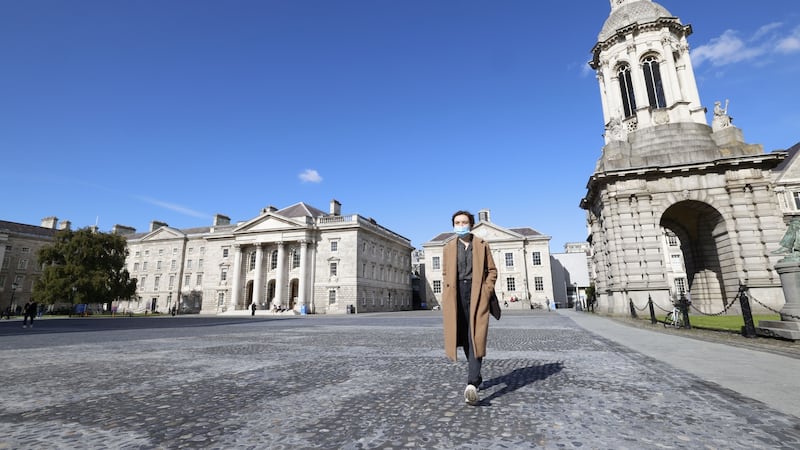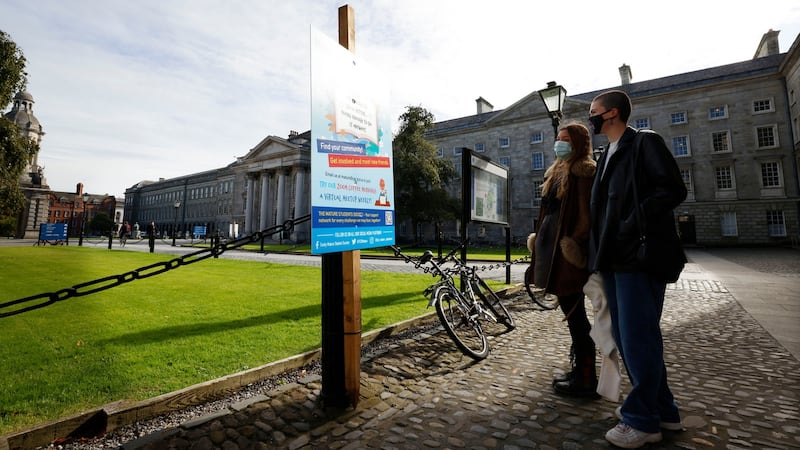The coming academic year will be like no other in the history of further and higher education, both within Ireland and internationally.
Third-year undergraduate students will be returning to colleges they last attended in person in March 2020 during the early weeks of semester two in their fresher year.
Incoming first- and second-year undergraduate students will, in many cases, be setting foot inside college grounds, lecture theatres and tutorial groups for the first time.
What they will encounter will be shaped by individual lecturers, departments and faculties’ experiences of enforced changes brought about by the Covid-19 pandemic.
Never in the history of university life, stretching back to when the oldest existing, and continually operating, educational institution in the world, the University of Karueein, founded in 859AD in Fez, Morocco, has there been such dramatic change in how education is delivered as has occurred in the past 18 months.
Within Europe young people have been attending universities since students first gathered in Bologna in Italy in 1088AD and in Paris "la Sorbonne" from 1160AD.
The advent of the printing press and the arrival of printed books, in the Middle Ages, could be regarded as an equivalent dramatic change to those brought about by Covid-19, in relation to how education is both delivered and consumed.
How has the third-level academic system changed?
Firstly, it must be acknowledged that herculean challenges have been successfully overcome by the teaching and lecturing staff of our higher and further education institutions over the past two academic years.
A system, based on a model of students turning up in person to attend lectures, studying from printed books and written lecture notes, and successfully navigating written or face-to-face assessment processes – which remained largely unchanged for over a thousand years – became inoperable overnight.
The entire system of delivery and assessment was reimagined and delivered, initially in a matter of days, and then refined and adapted as the days turned into weeks, and now into a second full academic year.
Roles across the academic, administrative and IT support structures of colleges were transformed, and changes, which would have taken a generation to introduce and bed down, were rapidly adopted.
The spectrum of success stretched from those academics who simply recorded their lectures on camera and put them up online for students to view in their own time, to those who completely reimagined how to teach their programmes through the medium of online education.
Covid-19, having transformed how programmes were delivered remotely, also forced a complete reimagination of how to assess students’ competency.

From my own involvement in the management of a number of higher and further education institutions, it is clear many of the innovations developed are recognised now to be best practice, and will be integrated into how programmes are delivered into the future.
So how have courses changed?
The printed prospectuses published by colleges in the autumn of 2020 to inform future students of their offerings went to the printers in mid-summer 2020, and probably were signed off by faculties by May of that year at the latest.
They are, in many ways, pre-Covid documents. Their course content and competency targets for each academic semester may still be accurate, but in terms of how programmes are delivered and assessed, these documents are, in many cases, historical.
Over the next three months our universities, institutes of technologies and further education institutes will have to determine how they will re-engage face to face with the student body from September 2021 onwards.
This process will, of course, be guided by Government regulations following advice from the public health specialists under the direction of Dr Tony Houlihan.
There will be no big bang reopening of institutions with thousands of students mixing freely on campus and in residencies. We saw the outcome of that experiment in the UK in September 2020, where hundreds of students became infected with Covid-19 within days of returning to campuses.
The next academic year will follow the pattern of the past 18 months, incremental steps back to a new normal, with ongoing reviews.
What will be the new normal?
It is unlikely we will see hundreds of students sitting in the likes of Theatre L & M in UCD, with a lecturer standing behind a podium, delivering a face-to-face lecture to students transcribing verbatim what is being said.
Post Covid-19, such a method of delivering content seems outdated and a massive waste of resources and energy, both on the part of lecturer and student alike.
The role of any good academic is to make content available to students with which they can familiarise themselves. Following that initial exploration of content, real learning takes place through discussion, analysis, presentations to tutorial groups, etc.
This interaction between teacher and student which has been taking place online for the past 18 months will hopefully migrate to face-to-face encounters early during the coming academic year.
Student assessments will also change radically as we return to campus life, taking on board the learning of the past two academic years. As with course delivery, how this evolves will probably take at least the next academic year to become clear.
What is also less clear is the extent to which students are going to have to be physically present on campus. Will it be for the entire 24 weeks of the academic term, and the usual three-week assessments at the end of each semester?
Will all students attend college full-time?
If course content is made available to students on the usual range of platforms (Moodle etc), and work is submitted through the same channels, will this change the dynamic of how institutions operate?
For many prospective students, the whole point of further education is to leave home, live full-time near college and engage fully with their fellow students in the social, cultural, sporting and, yes, academic life.
The prospect of working partially from home and attending college only when required will fill many Leaving Cert students and third-level students who have been working from their bedrooms for the past two years with dread.
But undertaking a degree programme partially remotely might offer opportunities to others whose personal or financial circumstances might make full-time attendance impossible.
Where does this leave the Leaving Cert class of 2021?
For this year’s sixth-year students, the main focus now, and in the immediate weeks ahead, will be their written papers.
But at some stage over the next four weeks students will have to finalise their CAO course choices, and any further education programmes they may be considering.
Students should communicate directly with programme directors and admissions office personnel, and ask how the specific courses they are interested in may have evolved and changed.
Colleges may not be in a position to provide much clarity just yet as the nature of what eventually emerges from the ongoing changes is still unclear and may remain so for some time to come.
In many ways the next academic year in all institutions will be more fluid than in any year in the history of higher education.
How everything operates within our educational institutions will evolve in academic, social, cultural, sport and other aspects of college life over the next few years. There is no roadmap or template other than our shared experience of battling and overcoming this deadly virus.

What is truly exciting is this rite of passage for young people – leaving home, securing accommodation, grappling with self-directed learning, mastering a discipline, forming life-long friendships and intimate relationships – which was incompatible with a coronavirus world in which the virus was still dominant, will hopefully become a reality for tens of thousands again this coming September.
This hope and expectation depends on how we as a society treat the threat of the virus during the coming summer months.
Pre-Covid online providers
Another option for aspiring college applicants would be to focus their third-level course choices on institutions which have a pre-coronavirus culture of delivering a significant proportion of their content online.
The National Institute for Digital Learning in DCU is a world leader at the forefront of designing, implementing and researching new blended, online and digital models of education.
DCU Connect, its online platform, offers a series of humanity and IT programmes originally designed for online delivery.
All Irish third-level colleges had, prior to Covid-19, elements of online programmes, but not as core parts of the delivery of their core functions. Covid-19 has banished that world forever, with online now and into the future being central to all teaching and learning.
Mainstream online learning opportunities
Many aspiring learners outside of the CAO process may opt for an online course over the more traditional university, on the basis that the quality of course delivery is proven, and that the programmes on offer, many at very low cost, were designed for online delivery from inception.
The methodology of delivery, support and assessments are of the highest quality, as providers such as the Open University or alison.com, one of the world's leading online course providers, which is based in Galway, have been in the business of delivering learning through this online model for many years.
Further education options
The CAO is, of course, not the only route forward for aspiring learners, nor are Leaving Cert students the only cohort hoping to reap the benefits of a more blended learning environment.
Many potential students of all ages who have a specific area of knowledge or study in mind, but who would benefit hugely from a preparatory pre-university year, both in terms of their knowledge of their subject matter, and their level of maturity and capacity to engage successfully in self-directed learning, may decide to consider a one-year QQI level 5 or two-year level 6 award, offered in their local or regional further education colleges.
Following completion of their programme they can go on to third-level study with a far lower possibility of college drop-out, according to data published by the Higher Education Authority, than those who proceed directly to college from school.
Similarly to their third-level colleagues, the teaching and lecturing staff of further education colleges have had to transform their methods of delivery and assessment over the past two years, and the advances and benefits of online delivery will be built into their programmes when they restart in September.






